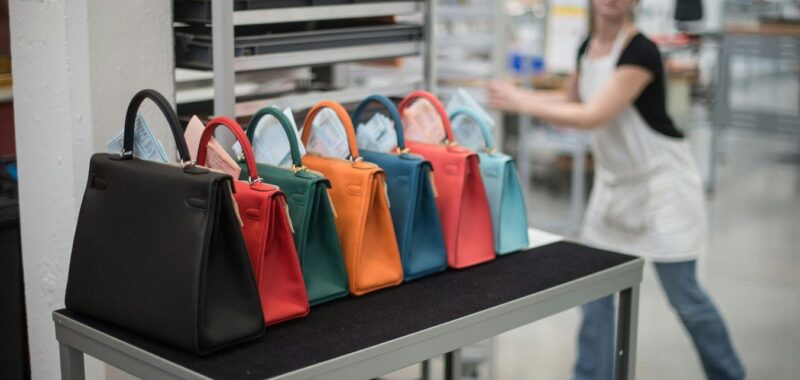Photo: SEBASTIEN BOZON/AFP via Getty Images
In an age where brand image is everything, an unexpected new voice is gaining traction in fashion’s transparency movement: the manufacturers themselves.
On TikTok, a growing number of Chinese suppliers are sharing behind-the-scenes footage of products they’re producing for global brands. Largely in response to Trump’s tariffs, these posts are part of what’s come to be known as “FactoryTok” and expose just how little some products cost before they’re marked up to eye-watering retail prices.
One viral video shows a manufacturer walking viewers through the process of producing a handbag sold for over $300 and revealing that the actual production cost was under $15. In another clip, a user showcases shoes for a major western footwear brand, outlining the costs to make totalling less than 10% of the final selling price. Many of these FactoryTok videos have since been removed, but not before amassing millions of views.
But this trend isn’t just about the social media shock factor and tariff retaliation. It’s about transparency. It’s about holding the fashion industry accountable for not just what it makes, but how and why it makes it.
Photo by Ezra Acayan/Getty Images
The truth behind markups
Of course, markups are nothing new within retail. From luxury heritage houses to mid-tier high street brands, markups are designed to cover far more than the cost of physical production. You’re also paying for design, marketing, logistics, brand prestige and, now more than ever, a promise of values. Values such as sustainability, ethics and responsibility.
Some luxury brands, like Kering (parent company of Gucci, Bottega Veneta, and Balenciaga), have invested in building ESG-forward practices and transparent supply chains, aiming to ensure source materials are responsibly obtained. LVMH has made similar commitments, including efforts in biodiversity and regenerative agriculture for raw materials.
These initiatives are encouraging but also expensive. Naturally, sourcing recycled cashmere or traceable organic cotton comes at a higher price than generic alternatives. Shouldn’t brands that genuinely invest in better practices be allowed to charge higher prices?
But here’s the question: what happens when sustainability becomes part of the markup, without delivering the substance?
When brands start charging premium prices under the banner of “sustainable fashion,” how do we know whether the added cost reflects real ESG efforts or simply capitalises on conscious consumerism?
Kering, whose brands include Gucci and Balenciaga, is recognised in luxury fashion for … More
And this brings us the greenwashing dilemma.
You’ve likely seen it before: capsule collections dubbed “Conscious,” “Responsible,” or “Planet-Friendly,” all shrouded in soft lighting and earthy colour palettes. Greenwashing — the act of misleading consumers into believing a product or brand is more sustainable than it really is — has become one of fashion’s most persistent issues.
For example, a t-shirt made of “sustainable fabric” that contains just 5% organic cotton. Or a brand claiming carbon neutrality without disclosing whether its offsets are verified or effective. Even major players like H&M have been called out for misleading marketing in their sustainability collections. In one lawsuit, items promoted as being made with 50% sustainable materials were found to be 100% polyester.
This is where FactoryTok becomes more than just voyeuristic content. It becomes a crowd-sourced tool, giving consumers access to information previously reserved for supply chain insiders. If we can now see the origin, cost, and production methods of our clothes from the very people who make them, greenwashing becomes harder to get away with.
What does this mean for brands?
We’re entering a new era of consumer power. Audiences are more informed, more sceptical, and more connected than ever. The glossy advertising campaigns and polished brand manifestos are no longer enough. If a claim can’t hold up under scrutiny — it’s getting called out.
The risk isn’t just reputational; it’s relational. Brands are built on trust, and today, values drive value. Consumers don’t just want to buy products — they want to buy from companies whose actions reflect their promises.
The smartest brands are leaning into this shift rather than resisting it. Take Vivobarefoot, for example. Their annual impact report Unfinished Business outlines their journey towards becoming a regenerative business, highlighting both successes and setbacks. It’s a transparent account of their efforts, in a bid to promote accountability and shared learning.
Transparency Is The New Trend.
Transparency doesn’t mean perfection. It means honesty. And increasingly, honesty is what consumers are willing to pay for. Because sustainability doesn’t just live in the products we choose to buy. Sustainable fashion lives in how those products are made, by whom, and under what conditions. Sustainability lies within the full story where ‘buying better’ is real, not just an Instagram caption.

